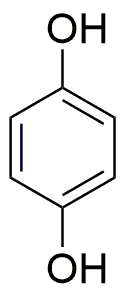Hydroquinone is widely utilized in research focused on:
- Cosmetic Formulations: Commonly found in skin lightening products, hydroquinone helps reduce hyperpigmentation and dark spots, making it a popular choice in dermatology.
- Photography: Used as a developing agent in black-and-white photography, it enhances the contrast of images, providing clearer and more defined photographs.
- Analytical Chemistry: Acts as a reducing agent in various chemical reactions, hydroquinone is essential in analytical techniques for determining the concentration of certain compounds.
- Polymer Industry: Employed as an antioxidant in the production of plastics and rubber, it helps prolong the life of materials by preventing oxidative degradation.
- Pharmaceuticals: Utilized in the synthesis of various drugs, hydroquinone plays a role in developing medications that require specific chemical properties for efficacy.
General Information
Properties
Safety and Regulations
Applications
Hydroquinone is widely utilized in research focused on:
- Cosmetic Formulations: Commonly found in skin lightening products, hydroquinone helps reduce hyperpigmentation and dark spots, making it a popular choice in dermatology.
- Photography: Used as a developing agent in black-and-white photography, it enhances the contrast of images, providing clearer and more defined photographs.
- Analytical Chemistry: Acts as a reducing agent in various chemical reactions, hydroquinone is essential in analytical techniques for determining the concentration of certain compounds.
- Polymer Industry: Employed as an antioxidant in the production of plastics and rubber, it helps prolong the life of materials by preventing oxidative degradation.
- Pharmaceuticals: Utilized in the synthesis of various drugs, hydroquinone plays a role in developing medications that require specific chemical properties for efficacy.
Documents
Safety Data Sheets (SDS)
The SDS provides comprehensive safety information on handling, storage, and disposal of the product.
Product Specification (PS)
The PS provides a comprehensive breakdown of the product’s properties, including chemical composition, physical state, purity, and storage requirements. It also details acceptable quality ranges and the product's intended applications.
Certificates of Analysis (COA)
Search for Certificates of Analysis (COA) by entering the products Lot Number. Lot and Batch Numbers can be found on a product’s label following the words ‘Lot’ or ‘Batch’.
*Catalog Number
*Lot Number
Certificates Of Origin (COO)
This COO confirms the country where the product was manufactured, and also details the materials and components used in it and whether it is derived from natural, synthetic, or other specific sources. This certificate may be required for customs, trade, and regulatory compliance.
*Catalog Number
*Lot Number
Safety Data Sheets (SDS)
The SDS provides comprehensive safety information on handling, storage, and disposal of the product.
DownloadProduct Specification (PS)
The PS provides a comprehensive breakdown of the product’s properties, including chemical composition, physical state, purity, and storage requirements. It also details acceptable quality ranges and the product's intended applications.
DownloadCertificates of Analysis (COA)
Search for Certificates of Analysis (COA) by entering the products Lot Number. Lot and Batch Numbers can be found on a product’s label following the words ‘Lot’ or ‘Batch’.
*Catalog Number
*Lot Number
Certificates Of Origin (COO)
This COO confirms the country where the product was manufactured, and also details the materials and components used in it and whether it is derived from natural, synthetic, or other specific sources. This certificate may be required for customs, trade, and regulatory compliance.


